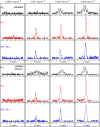Improved Detection and Quantification of Cyclopropane Fatty Acids via Homonuclear Decoupling Double Irradiation NMR Methods
- PMID: 37970028
- PMCID: PMC10634279
- DOI: 10.1021/acsomega.3c06538
Improved Detection and Quantification of Cyclopropane Fatty Acids via Homonuclear Decoupling Double Irradiation NMR Methods
Abstract
Over the years, NMR spectroscopy has become a powerful analytical tool for the identification and quantification of a variety of natural compounds in a broad range of food matrices. Furthermore, NMR can be useful for characterizing food matrices in terms of quality and authenticity, also allowing for the identification of counterfeits. Although NMR requires minimal sample preparation, this technique suffers from low intrinsic sensitivity relative to complementary techniques; thus, the detection of adulterants or markers for authenticity at low concentrations remains challenging. Here, we present a strategy to overcome this limitation by the introduction of a simple band-selective homonuclear decoupling sequence that consists of double irradiation on 1H during NMR signal acquisition. The utility of the proposed method is tested on dihydrosterculic acid (DHSA), one of the cyclopropane fatty acids (CPFAs) shown to be a powerful molecular marker for authentication of milk products. A quantitative description of how the proposed NMR scheme allows sensitivity enhancement yet accurate quantification of DHSA is provided.
© 2023 The Authors. Published by American Chemical Society.
Conflict of interest statement
The authors declare no competing financial interest.
Figures





Similar articles
-
Producing Cyclopropane Fatty Acid in Plant Leafy Biomass via Expression of Bacterial and Plant Cyclopropane Fatty Acid Synthases.Front Plant Sci. 2020 Feb 7;11:30. doi: 10.3389/fpls.2020.00030. eCollection 2020. Front Plant Sci. 2020. PMID: 32117373 Free PMC article.
-
Authenticity of Hay Milk vs. Milk from Maize or Grass Silage by Lipid Analysis.Foods. 2021 Nov 26;10(12):2926. doi: 10.3390/foods10122926. Foods. 2021. PMID: 34945477 Free PMC article.
-
Determination of Cyclopropane Fatty Acids in Food of Animal Origin by 1H NMR.J Anal Methods Chem. 2018 Apr 1;2018:8034042. doi: 10.1155/2018/8034042. eCollection 2018. J Anal Methods Chem. 2018. PMID: 29805838 Free PMC article.
-
Applications of Solution NMR Spectroscopy in Quality Assessment and Authentication of Bovine Milk.Foods. 2023 Aug 28;12(17):3240. doi: 10.3390/foods12173240. Foods. 2023. PMID: 37685173 Free PMC article. Review.
-
Screening of synthetic PDE-5 inhibitors and their analogues as adulterants: analytical techniques and challenges.J Pharm Biomed Anal. 2014 Jan;87:176-90. doi: 10.1016/j.jpba.2013.04.037. Epub 2013 May 6. J Pharm Biomed Anal. 2014. PMID: 23721687 Review.
References
-
- Sobolev A. P.; Thomas F.; Donarski J.; Ingallina C.; Circi S.; Cesare Marincola F.; Capitani D.; Mannina L. Use of NMR Applications to Tackle Future Food Fraud Issues. Trends Food Sci. Technol. 2019, 91, 347–353. 10.1016/j.tifs.2019.07.035. - DOI
-
- Lytou A. E.; Panagou E. Z.; Nychas G.-J. E. Volatilomics for Food Quality and Authentication. Curr. Opin. Food Sci. 2019, 28, 88–95. 10.1016/j.cofs.2019.10.003. - DOI
-
- Román S.; Sánchez-Siles L. M.; Siegrist M. The Importance of Food Naturalness for Consumers: Results of a Systematic Review. Trends Food Sci. Technol. 2017, 67, 44–57. 10.1016/j.tifs.2017.06.010. - DOI
LinkOut - more resources
Full Text Sources

